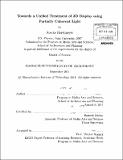Towards a unified treatment of 3D display using partially coherent light
Author(s)
Horstmeyer, Roarke (Roarke William)
DownloadFull printable version (15.34Mb)
Other Contributors
Massachusetts Institute of Technology. Dept. of Architecture. Program in Media Arts and Sciences.
Advisor
Ramesh Raskar.
Terms of use
Metadata
Show full item recordAbstract
This thesis develops a novel method of decomposing a 3D phase space description of light into multiple partially coherent modes, and applies this decomposition to the creation of a more flexible 3D display format. Any type of light, whether it is completely coherent, partially coherent or incoherent, can be modeled either as a sum of coherent waves or as rays. A set of functions, known as phase space functions, provide an intuitive model for these waves or rays as they pass through a 3D volume to a display viewer's eyes. First, this thesis uses phase space functions to mathematically demonstrate the limitations of two popular 3D display setups: parallax barriers and coherent holograms. Second, this thesis develops a 3D image design algorithm based in phase space. The "mode-selection" algorithm can find an optimal holographic display setup to create any desired 3D image. It is based on an iterative algebraic-rank restriction process, and can be extended to model light with an arbitrary degree of partial coherence. Third, insights gained from partially coherent phase space representations lead to the suggestion of a new form of 3D display, implemented with multiple time-sequential diffracting screens. The mode-selection algorithm determines an optimal set of diffracting screens to display within the flicker-fusion rate of a viewer's eye. It is demonstrated both through simulation and experiment that this time-sequential display offers improved performance over a fixed holographic display, creating 3D images with increased intensity variation along depth. Finally, this thesis investigates the tradeoffs involved with multiplexing a holographic display over time with well-known strategies of multiplexing over space, illumination angle and wavelength. The examination of multiplexing tradeoffs is extended into the incoherent realm, where comparisons to ray-based 3D displays can hopefully offer a more unified summary of the limitations of controlling light within a volume.
Description
Thesis (S.M.)--Massachusetts Institute of Technology, School of Architecture and Planning, Program in Media Arts and Sciences, 2011. Cataloged from PDF version of thesis. Includes bibliographical references (p. 111-120).
Date issued
2011Department
Program in Media Arts and Sciences (Massachusetts Institute of Technology)Publisher
Massachusetts Institute of Technology
Keywords
Architecture. Program in Media Arts and Sciences.